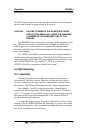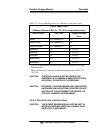
Operation MX300-I
Teledyne Analytical Instruments 30
After exposure to nitrous oxide mixtures, the sensor should be left
in 100% oxygen overnight (e.g., left in a breathing circuit that has been
flushed with pure oxygen). If this is not practical, when using the Tee,
remove the plastic flow diverter and leave the sensor in room air. If the
oxygen reading continues to drop after each use in nitrous oxide the
sensor should be removed from service. If the sensor can no longer be
calibrated or if there is any sign of electrolyte leakage, the sensor should
be disposed of in accordance with local regulations and the Material
Safety Data Sheet (MSDS). Contact Teledyne for the Material Safety
Data Sheet.
2.3.6 Cleaning
The MX300-I and R17MED sensor are non-sterile devices.
The oxygen analyzer, oxygen sensor, and sensor interconnection
cable may be cleaned by wiping the surfaces with isopropyl alcohol or a
mild cleaning solution.
Before placing instrument in operation make sure all surfaces are
dry and unit is properly calibrated.
When cleaning, do not allow liquids or moisture to enter the
instrument or sensor internal cavities. Do not allow the cleaning solution
to come in contact with the electrical connections. Do not immerse the
instrument, oxygen sensor or sensor interconnection cable in water or
any other liquid.
Do not expose the instrument, oxygen sensor and interconnection
cable to steam, ethylene oxide, or radiation sterilization.
2.4 Do’s and Don’ts
– DO –
• Read all of the directions before using for the first time.
• Calibrate every 8 hours or before every use.
• Visually inspect the sensor for leakage before each use.
• Calibrate using 100% oxygen and check in air.
• Check the HI and LO alarm settings prior to each use.


















